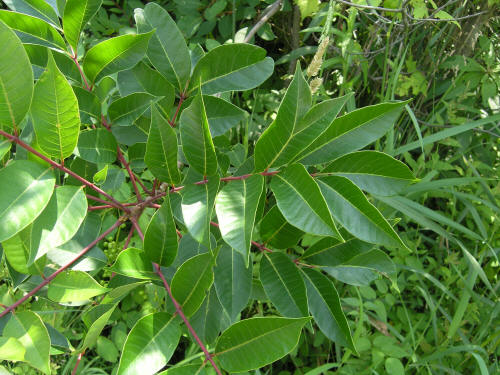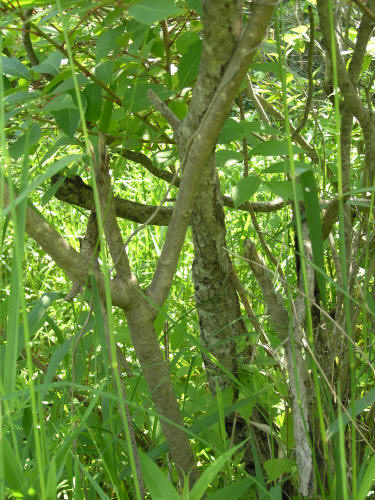
Go to Midwest Weeds and Wildflowers Home Page
Poison Sumac
Toxicodendron vernix (L.) Kuntze
Anacardiaceae (Cashew Family)

▲▼ Mature trees, about 8-15 feet tall

▲▼ pinnately-compound leaflets with reddish center rachis
▲ smooth,, reddish twig
▲▼ leaflets tend to be oriented upward from leaf rachis, rather than horizontal or drooping, as in other sumacs
▲▼ cluster of greenish-white fruit near branch tips

▲ gray bark, smooth on younger plants, more furrowed on older
Toxicodendron vernix (L.) Kuntze; Poison-sumac: (Bayer Code: TOXVX; US Code TOVE)
·
Has
pinnately compound leaves, and is currently not found in Missouri
·
Native small tree, with toxic oils on leaves, fruit, all parts of plant,
similar to poison ivy and poison oak
·
Leaves are pinnately-compound, with smooth glossy leaflets held upright
from central, reddish rachis
·
Has white flowers in loose, open clusters in late spring, followed by
whitish, berry-like fruit in fall, arising from leaf axils (not at very tip of
stems as with other sumacs)
·
Needs wet to moist soils (commonly found in wetland areas)
·
Note:
o
Poison sumac is less common in most of midwest compared to other upland (dryer
soil) sumacs
(staghorn
sumac,
dwarf/winged sumac,
smooth sumac), which are not poisonous
o
These other sumacs tend to have leaflets that are horizontal or
drooping, compared to poison sumac
o
These other sumacs have terminal (stem tip) flower and fruit clusters,
not open clusters in leaf axils
Special Thanks to Dr. Peter Carrington, Michigan State University, for leading us to this floating bog wetland site near East Lansing, MI to get these photos.
Go to Midwest Weeds and Wildflowers Home Page
Updated 15 January 2019